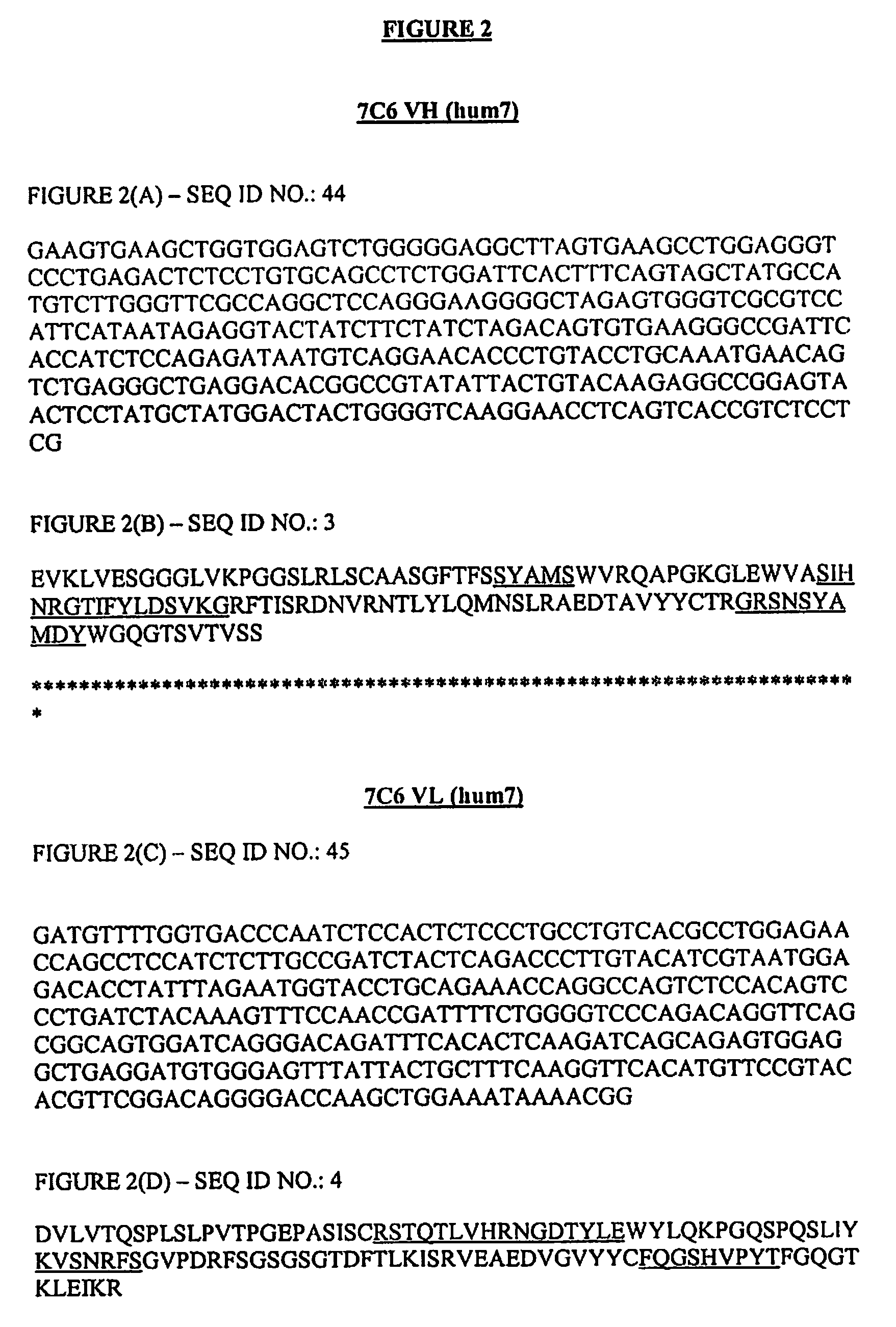Humanized antibodies to ab (20-42) globulomer and uses thereof
a technology of humanized antibodies and globulomers, applied in the field of antibodies, can solve the problems of unmet therapeutic needs, inducing negative and potentially lethal effects on the human body, and causing a lot of damage to the human body
- Summary
- Abstract
- Description
- Claims
- Application Information
AI Technical Summary
Benefits of technology
Problems solved by technology
Method used
Image
Examples
example i
Preparation of Globulomers
a) Aβ(1-42) Globulomer:
[0330]The Aβ(1-42) synthetic peptide (H-1368, Bachem, Bubendorf, Switzerland) was suspended in 100% 1,1,1,3,3,3-hexafluoro-2-propanol (HFIP) at 6 mg / mL and incubated for complete solubilization under shaking at 37° C. for 1.5 h. The HFIP acts as a hydrogen-bond breaker and is used to eliminate pre-existing structural inhomogeneities in the Aβ peptide. HFIP was removed by evaporation in a SpeedVac and Aβ(1-42) resuspended at a concentration of 5 mM in dimethylsulfoxide and sonicated for 20 s. The HFIP-pre-treated Aβ(1-42) was diluted in phosphate-buffered saline (PBS) (20 mM NaH2PO4, 140 mM NaCl, pH 7.4) to 400 μM and 1 / 10 volume 2% sodium dodecyl sulfate (SDS) (in H2O) added (final concentration of 0.2% SDS). An incubation for 6 h at 37° C. resulted in the 16 / 20-kDa Aβ(1-42) globulomer (short form for globular oligomer) intermediate. The 38 / 48-kDa Aβ(1-42) globulomer was generated by a further dilution with three volumes of H2O and in...
example ii
Generation and Isolation of Humanized Anti-Aβ(20-42) Globulomer Monoclonal Antibodies
Preparation of Humanized Antibodies:
[0334]For humanization of the 5F7 variable regions, the general approach provided in the present invention was followed. First, a molecular model of the 5F7 variable regions was constructed with the aid of the computer programs ABMOD and ENCAD (Levitt, M., J. Mol. Biol. 168: 595-620 (1983)). Next, based on a homology search against human V and J segment sequences, the VH segment MUC1-1′ CL (Griffiths, A. D., et al., EMBO J. 12: 725-734 (1993)) and the J segment JH4 (Ravetch, J. V., et al., Cell 27: 583-591 (1981)) were selected to provide the frameworks for the Hu5F7 heavy chain variable region. For the Hu5F7 light chain variable region, the VL segment TR1.37′ CL (Portolano, S., et al., J. Immunol. 151: 2839-2851 (1993)) and the J segment JK4 (Hieter, P. A., et al., J. Biol. Chem. 257: 1516-1522 (1982)) were used. The identity of the framework amino acids between ...
example iii
Characterization of Generated Antibodies
Competition ELISA
[0342]The following protocol was utilized to carry out the Competition ELISA assay:
[0343]Initially, the plates (1 plate / experiment) were coated overnight with A-Beta antigen (1-42) at a concentration of 5 μg / mL in phosphate buffered saline (PBS). The following day, the supernatant was discarded, and the plates were blocked with 340 mL of Super Block buffer (Pierce, Rockford, Ill.) for 45 min. The plates were then emptied, and the biotinylated 7C6 or 5F7 mouse antibody was added at a concentration of 1 μg / mL. (Volume=100 μL) Other antibodies (mouse or humanized 5F7; or mouse or humanized 7C6) were added at concentrations ranging from 27 μg / mL to 0.11 μg / mL. (Volume=50 μL) The plates were then incubated for two hours and washed 5× times with Phosphate Buffered Saline (PBS). Neutra Avidin HRP was added as a secondary reagent (dilution 1:20,000; volume=100 μL). The plates were then incubated for 30 min. and washed 5× times. TMB (I...
PUM
| Property | Measurement | Unit |
|---|---|---|
| dissociation constant | aaaaa | aaaaa |
| dissociation constant | aaaaa | aaaaa |
| dissociation constant | aaaaa | aaaaa |
Abstract
Description
Claims
Application Information
 Login to View More
Login to View More - R&D Engineer
- R&D Manager
- IP Professional
- Industry Leading Data Capabilities
- Powerful AI technology
- Patent DNA Extraction
Browse by: Latest US Patents, China's latest patents, Technical Efficacy Thesaurus, Application Domain, Technology Topic, Popular Technical Reports.
© 2024 PatSnap. All rights reserved.Legal|Privacy policy|Modern Slavery Act Transparency Statement|Sitemap|About US| Contact US: help@patsnap.com










